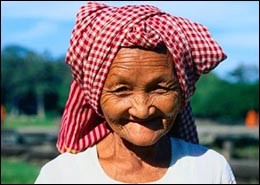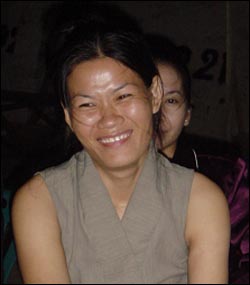 PEOPLE PEOPLE |
The population of Cambodia includes various
ethnic groups such as Khmer, Chinese, Vietnamese,
Cham and Hill tribes. About 80% of the population
defines itself as Khmers, the major ethnic
group.
Nowadays, there are around 90 men to 100
women and more than half of the population
is under the age of 15, of which 250.000
are orphaned children, due to the many years
of conflict. In 1979, the total population
of the country was estimated around 6 million;
the present rate of population growth (4
to 4.5%), which is one of the highest in
the world, has nevertheless allow an impressive
growth to reach close to 13 million people
nowadays. The life expectancy is actually
of 54 for men and 60 for women.
The average national population density
is 72 people/km². The main concentration
of population being in the central planes,
around the resourceful Tonle sap lake and
around the capital city Phnom Penh; and
the least populated being the Ratanakiri
province, in the east of the country mainly
inhabited by the hill tribes due to non
adequate road infrastructure, which restrains
the access.
Almost ten million people live in the countryside,
predominantly working in the agricultural
sector. Farmers generally cultivate rice
twice a year, once during the dry season
from March to May and then again in the
rainy season from June to February. Due
to most farmers possessing only small land
holdings their level of income is quite
low and so they mostly practice ancient
methods of cultivation such as using oxen
or buffalo to plough the fields. When the
farmers have free time between seasons they
look for other ways to supplement their
income such as harvesting palm tree seeds
to produce palm juice, fishing, cutting
wood to produce charcoal and harvesting
vines, water lilies, lotus and bamboo.
In this context migration to towns still
remains an important problem. Most young
people looking for further incomes to support
their families will enrol as a moto-dop,
for the men; in garment factories, for women;
or in any parallel activity that grants
the city.
 ETHNIC
GROUPS ETHNIC
GROUPS |
KHMERS
Although their origins are unknown, Khmer
are most probably a mix of Mongol and Melanesian
at origins. Other accounts suggest that
they may come from other parts of Asia such
as Malaysia or Indonesia.

In physical terms Khmers are darker, huskier
and taller than their neighbours and most
of them have black curly hair. Their eyes
tend to be rounder than the other population
of the region. Nevertheless, due to a huge
variety of ethnics group that have lived
in Cambodia and intermarriage, it is difficult
to say what a "pure" Cambodian
looks like. The traditional dressing is
the sarong, dress still worn by khmer and
Chams, typically knotted at the waist, but
modern dressing is widely spread, particularly
in the main cities.
Khmer are in their majority still living
in rural areas and in regards to their religion,
cultivating its fields and taking care of
its family is regarded as an end in itself.
Khmer people are friendly and easygoing.
They like to be sociable and enjoy their
work. In this aspect hard work is often
carried out in a very relaxed manner. As
religious beliefs stress the temporary nature
of earth existence, the importance of spiritual
contentment has strong roots in the Cambodian
nature. This latter could also explain the
amazing courage and optimism that Cambodian
display to rebuilt their lives after more
than 3 decades of conflicts and civil war.
VIETNAMESE
The Vietnamese immigration in Cambodia has
always existed. During the French protectorate,
the Indochina peninsula era, they were strongly
encouraged to come as they were considered
as hard workers. In 1975 they were believed
to be around 250.000 inhabiting Cambodia.
During the Pol Pot regime, most of them flew
back to Vietnam and this number decreased
dramatically. Nevertheless the Vietnamese
invasion in 1979 gave them a good chance to
come back and install themselves in Cambodia,
where living was far easier than homeland.
Nowadays Vietnamese are without any doubt
the largest non-khmer ethnic group in Cambodia;
official statistics estimate that there are
around 300.000 of them, nevertheless external
observers estimate this same figure to more
than a million. Their main living activity
is the fishing in the Tonle sap area and the
small and medium businesses in the urban centres.

Cambodian and Vietnamese differ in a lot
of points; Vietnamese are definitely more
influenced by the Chinese culture than Cambodians,
which have been indianized such as Thailand.
The cult of both countries is also very
different, as well as the writing and speaking.
Nowadays Khmers still refer to Vietnamese
as "Yuon". These cultural differences
as well as an historical fight between the
two countries and land disputes (including
the actual Kampuchea Krom, under Vietnamese
control) have created some ethnic rivalries
that remain actuality. Last elections, in
July 2003, have proved this fact with two
of the main major political parties, Funcipec
and Sam Rainsy, having both as main point
of their campaign the expulsion of Vietnamese
out of the country.
|
CHINESE
Although the Chinese immigration to Cambodia
had began since the 3rd century B.C the
main influx occurred during the second half
of the 19th and 20th century. As other non-Khmer
ethnic groups, they were persecuted during
the Khmer rouge regime and many of them
left the country. This phenomenon also continued
during the Vietnamese presence but in recent
year, since 1991, this immigration has stopped
but there is still an important Chinese
community living in Cambodia.
Traditionally the Chinese have made their
leaving as merchants and traders and have
always hold an important part of the economic
life of the country, which remain true nowadays.
Although inter-ethnic weddings are not infrequent,
the Chinese community still retain a significant
degree of cultural distinctiveness.
CHAM
The Chams are the descendants of the Kingdom
of Champa one of the first Hindu-influenced
state that flourished in South East Asia,
despite many fights with the Khmer and Chinese,
before the Vietnamese finally conquered
them in the 15th century. They have been
then assimilated by Malay traders and converted
to Islam, reason why they are often also
called locally "Khmer Islam".
They have also been persecuted during the
pol pot regime, and many of their mosques
were then destroyed. Nevertheless due to
a friendly climate between religions these
latter have been rebuilt in recent years.
Officially they are around 240.000 Chams
still living in Cambodia, but as Vietnamese,
the unofficial account would be more averaging
half a million of them.
Traditionally, Cham men are cattle dealers,
fishermen and boat builders. This fact certainly
explains that geographically they are still
settled in the banks of the Mekong and the
Tone Sap River, where they can earn their
living. Their actual dressing is similar
to the Khmer one with mean wearing sarongs
and women long-sleeve jackets.
HILL TRIBES
Cambodia's diverse ethno-linguistic minorities
or hill tribes, include a variety of ethnic
groups that share the same geographic environment,
the mountainous regions of the country,
and are accounting for around 70 000 people.
Among these groups we can distinguish the
Saoch in the Elephant Mountains; the Pear
in the Cardamom Mountains; the Kreung, Jarai
and Tampuan (or Tumpoun, which is considered
to be the largest group), along the border
with Laos; the Kuy in the far northeast
of the country; and many more, such as the
Pnhongs, Stieng, Kra Chock, Kavet, Brao,
etc.
Due to their geographical isolation these
tribes escaped from the persecutions of
the Khmer rouge regime. For the same reasons,
they haven't integrated the modern Cambodian
usages and have conserved a traditional
way of living. Hunting and fishing as well
as cultivation are their main activity.
The main crop in their diet is dry or upland
rice, cultivated by the slash and burn method.
Houses are usually important multi-families
structures and may be built on the ground
or on stilts. Their appearance is also peculiar
due to the importance attached to personal
decoration such as ears piercing and tattoos..
 LANGUAGES LANGUAGES |
Khmer, most widely spoken language of the
Mon-Khmer family, is the official language
of Cambodia. Immigrant communities also
speak Vietnamese and Chinese. The Cham people
as well as some hill tribes, even if fluent
in Khmer, still conserve their traditional
languages; nevertheless these latter are
increasingly being marginalized. English
is rapidly gaining popularity like in the
whole region, particularly among the young,
while educated older people speak French.
Chinese tend also to develop rapidly due
to an important influence of the Chinese
businessmen over local economy.
Written Khmer is one of the long lasting
influences of India over the country through
the Pali (religious Buddhist language) and
the Sanscrit. Nowadays there is two different
form of writing, both from left to right
with no space between words; an angular
form, called Chrieng; and a round script,
called mul, which is reserved for special
occasions, both remain beautiful examples
of calligraphy.
There are 23 vowels sounds and 33 consonants
and, unlike most of Asian countries, Khmer
has no tones. The spoken form of Khmer also
integrates words from French, Vietnamese,
and Chinese origins. A peculiarity of the
Khmer language is that there is no tense,
only the present, and time reference is
made with the use of extra words: tomorrow,
yesterday, etc..
The Khmer language also reflects in its
structure and vocabulary the particularity
of their culture. To begin with there is,
in Khmer, a number of different words you
will use to address to another person that
could be all traduced in English by "you".
In fact depending on the social status of
the person you are talking to, as well as
your own position in the society, the word
used will be different. This fact enhances
the importance that the social layers still
have in the Cambodian culture. On the other
side, Cambodia is renowned to be an agricultural
country, and it is proven by the fact that
Khmer language includes more than 100 different
words to refer to the rice, main crop of
the country.
 EDUCATION EDUCATION |
Education is a key point for Cambodia's
reconstruction. In fact from a widely educated
country, accounting more than 20.000 teachers
in 1975, the Khmer rouge regime, which destroyed
every textbook along with schools, equipment,
facilities and teachers, have ruined the
educational system of Cambodia. The Royal
Government of Cambodia have nevertheless
understood the importance of the situation
and have put an emphasis during the last
years to build up schools and train teachers,
which are estimated at around 70,000 in
present days. In addition to the elementary
education and universities, there are many
training centers, which delivers certification
in computer and English mainly. Master degrees
are also available and many donors' countries
propose a wide program of scholarship in
order to support this initiative.
 WOMEN
IN SOCIETY WOMEN
IN SOCIETY |
Even if marriage is still often arranged,
and the young women have little changes
to veto the choice of her parents, women
have traditionally been regarded as equal
partners in marriage. Their role, within
the family is to run the house and bring
up the children. They are also in charge
of the family's domestic budget and the
purchase of food. This fact can be illustrate
by the Khmer proverb that says; "if
you are a colonel, than your wife is a general".
Nevertheless obedience and respect to the
parents and then to the husband is the key
point to be an honourable woman. Furthermore
due to this pre-determinate destiny, women
have still less access to further education,
as families will give priority to their
sons.
|

